Watsonia Hybrids



Stemless / Acaulescent
A plant that has no stems, when the flower stalks and leaf blades are produced from ground level.
Clumping
A plant that when multiplies forms a clump.This cormous perennial has erect dark green lanced-shaped leaves and forms a spreading clump. The white, pink, rose or mauve and orange tube-shaped flowers appear in a spike high above the foliage on a slender stem during spring.
Watsonia Hybrids are naturally found in South Africa and comprises of around 60 species that grow from the coast to the inland mountains appearing from sea level to an altitude of 1500 m (4,921 ft) or more. They prefer a well drained and poor to moderately fertile moist sandy-stony to light clay soil, that is acidic to neutral with a pH range from 5.0 to 7.5. They grow in an open sunny position and are frost and drought tolerant.
The South African Bugle Lily is a reliable flowering perennial that is grown for is spreading habit and flowers. It is planted along herbaceous borders in small or cottage gardens or grown in containers. It naturalises in woodland settings but care should be taken as it becomes weedy. It is also an excellent cut flower and may remain growing undisturbed for many years. It establishes in 1 - 2 years from division and has a medium water requirement, (Scale: 2-drops from 3) preferring to have reliable moist organic rich soil during the growing period but tolerates dry periods. Certain species have become a weed in some regions of the east coast of Australia (Watsonia meriana var. bulbillifera) and should not be planted around bushland fringes, particularly along water courses.
Control methods for Watsonia meriana var. bulbillifera include physically removing young or mature plants including the corms, which is difficult and remove off site. Paint the foliage with glyphosate or to damaged stems. It is best to carry out the removal during late autumn then follow up removal during early spring and bag up bulbils before they disperse.
I.D. 743
UK hardiness zone H5
Climate zones 4 - 24
USDA Zone 9-10
Watsonia (wot-SON-ee-a) Hybrids
Etymology
Genus: - Watsonia – after Sir William Watson (1715-87), London physician and botanist

South Africa
Iridaceae (eye-rid-AY-see-ee)
Iris Family
Distribution
This large family of herbs appear throughout the world in temperate and tropical regions predominantly in South Africa and Central and Southern America in open scrub, grasslands and deserts with some species in forests. They are absent in India and central Australia.
Diagnostic Features
These plants are monocotyledon perennial herbs rarely annual and form a tufted habit or a solitary leaf. They normally have a swollen rhizome or a corm and or bulb that are surrounded by fibres.
The leaves are simple, linear, lax or stiff with a basal arrangement normally in 2 vertical rows and imbricate with open or closed sheathing at the base and commonly appear with the flowers..
The regularly or irregular bisexual flowers may have an inflorescence that is solitary or branched cyme, raceme or spike enclosed within spathes at the base. The flower have 6 petaloid segments that are arranged in 2 simular whorls with the inner whorl sometimes reduced as in Iris or absent and are fused at the base forming a tube or funnelform or are free.
There are normally 3 stamens with the filaments commonly epipetalous (attached to the corolla tube) and the anthers opening with longitudinal slits. The style is 3 branched or lobed (filiform or expanded) with the stigma placed in different position depending on the pollinating mechanism.
The ovary is inferior rarely superior with 3 fused carples with 1 - 3 locules and axile placentas with numerous ovules.
The fruit is a loculicidal capsule that contains many brown seeds that have a small embryo.
There are 70 genera with around 18,000 species worldwide.
Note:
Many of the species are grown as ornamental plants for gardens or indoors with some of the South African species regarded as weeds in Australia.
This plant tolerates between USDA zones 9a to 10a and grows to 1.5 m (3 ft)
Fahrenheit 20º to 30º F
These temperatures represent the lowest average.
Celsius -3.9º to -1.1º C
Attention
This plant was last revised on the 29/3/2023
All photographs and data are covered by copyright. Apart from any fair dealing for the purpose of private study, research, reference or review, as permitted under the Copyright Act, no part including images and text may be reproduced by any means without written permission. The information presented in the map is only indicative and may contain errors and omissions. All inquiries should be addressed to sales@plantfile.com attention Peter Kirkland.

Simple
The leaf that is not divided.
Lanceolate
Broadest at the centre, three or more times long as broad (Lance-shape).
Basal
When the leaves grow from the base of the plant or radically from the root-shoot point.
Entire
A leaf margin with no irregularities (smooth).
Tubulate
A flower that forms a tube shape.
Spike
It is an unbranched inflorescence with sessile flowers (a simple raceme).| Jan | Feb | Mar | Apr | May | Jun |
| Jul | Aug | Sep | Oct | Nov | Dec |
The flower shape varies from tubulate to funnelform with a colour range from white, pink, rose or mauve and orange and are up to 65 mm (2 3/8 in) long. They are arranged in a long spike that is held above the foliage on a slender scape and appear during spring. Cultivars have more variations in colour.

Capsule
A dried dehiscent fruit, with an enclosing membrane normally containing may seeds."The South African Bugle Lily is a reliable flowering perennial that is grown for is spreading habit and flowers. It is planted along herbaceous borders in small or cottage gardens or grown in containers. It naturalises in woodland settings but care should be taken as it becomes weedy. It is also an excellent cut flower and may remain growing undisturbed for many years. It establishes in 1 - 2 years from division and has a medium water requirement, (Scale: 2-drops from 3) and responds to mulching.
Note:
Certain species have become a weed in some regions of the east coast of Australia and should not be planted around bushland fringes, particularly along water courses
Divide corms during autumn and replant immediately. Sow fresh seed during spring and maintain a temperature of 16º to 18º C (61º to 64º F).
Propagation by Seed (General)
Germination
In order for a seed to germinate it must fulfil three conditions.
1. The embryo must be alive (a viable seed).
2. The seed must have no dormancy-inducing physiological, physical or chemical barrier to germination; also the seed must be nondormant.
3. The seed must have the appropriate environmental requirements, water, temperature and oxygen.
The interaction between these requirements and dormancy is complex and may lead to different environmental requirements that avoid the dormancy of a seed.
Sowing Seeds in Containers
There are two general methods for germinating seeds.
1. Sowing seeds in a flat or germinating bed, through which seedlings are pricked-out then, transplanted into another flat with wider spacing or directly to an individual pot.
2. Sowing seeds by placing them in to flats with the appropriate spacing or into individual pots.
This method is normally carried out with medium to large seeds such as woody plants and plants that are difficult to transplant.
Seedling production normally occurs in a greenhouse / glasshouse, cold frames and on hot beds.
Method of Seed Sowing
Fine seed is sown in pots or flats that are no deeper than 70 to 80 mm. using a sterilised well-drained media (soil). Fill the container to 20 mm from the top and sprinkle sieved peat to 3 mm depth.
Press the media down level and firm with a piece of timber and then thoroughly moisten.
Mix the fine seed with washed sand and then sow thinly on the surface. These may be lightly covered with sand.
Larger seeds may be covered with media or a hole is dibbled and the seed is placed in the media.
Watering Methods
For watering you may either mist the containers from above or place the container in tepid water and allow the water to raise through the pot to the surface of the media, then drain away and do not fill to the top of the container.
Place a piece of glass over the pot and store in a protected warm environment (glasshouse).
Seeds germinate best in darkness so shade the containers if in direct sunlight.
After the seedlings have sprouted remove the glass and ease the seedlings into direct light.
When the seedlings are large enough prick them out and transplant into larger containers then place them in a shade house to harden off.
Many seeds have different methods of seed preparation for germination such as nicking or cutting the seed coat to allow water penetration, also placing seeds in hot water and allowing it to cool off.
This is particularly important as it is softening the seed coat.
Bulbs, Tubers and Corms
This is an underground organ with a short fleshy stem and a flower primordium that is enclosed by fleshy scales. The structure of this monocotyledon is designed for food storage and reproduction.
Tunicate Bulbs daffodils, tulip, onion
These bulbs have a dry outer layer that protects the fleshy concentric inner scales as in an onion forming a solid appearance.
Nontunicate Bulbs lilies
These bulbs have no protective dry outer layer and are easily damaged. The scales are separate and are attached to the basil plate so care should be taken to keep them moist, as drying is detrimental to their health. Roots appear from the base and in some cases from the stem, normally growing during mid summer to autumn.
Offsets or Bulblets
This type of propagation is used on many bulbs which are normally removed when the bulbs are lifted then planted as separate plants. Some plants require a few years to produce offsets and they can remain on the plant undisturbed for many seasons.
Tulip produces offsets and should be lifted when the foliage dies off and daffodil forms offsets (split) over several years. These offsets may be stored or planted up directly.
Lilies increase slowly but the bulb in some species may be split and the scales produce bulblets as with other lily species bulblets are produced at the base.
Stem Cuttings
Lily species may be grown from stem cuttings where bulblets form at the base of the stem or leaf-bud cuttings with a single leaf and an old stem heal, the bulblets will form in the axil of the leaf.
Basal Cuttage
This method includes 'scooping' and 'scoring' on larger bulbs 170 mm (6 7/10 in) diameter. Scooping is carried out with a curved blade removing the basal plate of the bulb. Adventitious bulblets develop on the exposed scales.
The scoring method involves three cuts through the basal plate of the bulb, which produces bulblets in the axils of the scales.
In both of these methods the bulbs are planted out for one to two seasons where the mother bulb disintegrates and the bulbils multiply and grow.
Leaf Cuttings
This method is used for blood lily, hyacinth and other species. Well-developed leaves are cut from the base, then cut into sections and planted in a rooting medium 30 mm (1 1/8 in) deep. In a few weeks bulbils will develop at the base of the leaf. These are then potted up and grown on.
Bulb Cuttings
Narcissus, Hippeastrum, Cooperia and many other species may be propagated in this method.
The mature bulb is cut into eight to ten sections each containing a part of the basal plate. These are planted in a rooting medium vertically as to just show the tip and maintained in a warm environment. Bulbils will form at the basal plate with in a few weeks. After developing the bulbils are potted up.
Corm
The corm is a swollen base that is covered in a protective tunic, which prevents drying out. It is composed of scale like leaves that have nodes and internodes where axillary buds develop. There are two types of roots, fleshy contractile from the new corms and fibrous from the base of the mother corm.
After the foliage dies off the corm is lifted and allowed to stand after which old corms, new corms and cormels are separated.
The cormels are stored during winter and planted during spring after soaking in water for 2 to 3 days. These may be planted into containers or in a prepared bed and allowed to grow on for one season.
The corm may also be divided by cutting it into sections, which develop into new corms.
Tubers
This is a swollen underground stem that acts as a food storage organ with nodes and small buds as in the potato. Tubers may be propagated by either cutting the tuber in to pieces that contain buds (eyes) with sufficient stored food for growth or planted as a complete tuber.
Tuberous Roots and Stems
These tuber roots differ in that there are no nodes or internodes and the buds are only produced at the crown with fibrous roots at the opposite end. The tuberous stems have a vertical orientation and arise from the first nodes as in Cyclamen species.
One or more bud is produced at the top of the crown and may be propagated by dividing the tuber so that it contains a shoot bud. Each section should be dried for a few days and stored in sawdust or vermiculite to avoid shrivelling.
In a warm humid environment the tubers will shoot.
Rhizomes
A rhizome is a stem that grows horizontally either below or on the surface of the soil with the shoots growing vertically as in bamboo and many grasses. The stems are composed of nodes and inter nodes giving it a segmented appearance.
Propagation is normally carried out by division during spring and autumn, by cutting the rhizome into sections each with at least one node. Placed on a moist bed or slightly buried and kept warm will produce roots and shoots from the nodes.
Pseudobulbs
This is a large fleshy section of the stem that may have one or several nodes. They are produced on orchids and may vary depending on the species. They are propagated from offsets, which develop at the nodes or by division of the rhizome containing pseudobulbs during the dormant period.
PEST
NAME
Thrips (General)
Various Thrip Species
ORDER
Thysanoptera
Description of the Pest
There are many species of thrips that attack living and dead plant material. The winged adults are black, yellow, white or brown with slender bodies and up to 2mm long. The folded fringed wings appear as silvery stripes and the smaller nymphs are difficult to see, but are wingless simular to the adults. Both adults and the first two nymphal stages have rasping and sucking mouthparts.
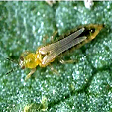 Thrip species
Thrip species
Boree Gall (Kladothrips species) adults are gall producing thrips that form smooth bubble-like or irregular spiny growths on the leaves. These galls can contain up to 1000 insects that also reproduce inside, and are trapped until the gall dries or splits open. Commonly found in inland areas attacking the phyllodes of Acacia species.
Glasshouse Thrips (Heliothrips haemorrhoidalis) is a slender up to 15mm long with small fringed wings. The adult lays eggs on the underside of leaves where the nymphs emerge as miniature adults but wingless. Then feed on the soft leaves leaving a silvery mottled appearance.
Appearance and Distribution of the Pest
Thrips are found from tropical to temperate regions preferring a cool mild winter followed by a dry sunny spring that produces abundant flowers and new foliage. It is dispersed by flying and can be carries great distances on the wind.
Life Cycle
These insects have a Hemimetabolous life cycle, ie. When the immature nymphs resemble the adults.
The female adult lays her eggs using an oviposit in a slit on flower stems or occasionally leaves. The eggs develop into four nymphal stages. The first two stages occur on the plant and the last two in the surrounding soil or in leaf litter, emerging as adults and flying to reinfect the plant. It takes ten to thirty days to develop from egg to adult depending on the temperature and rainfall. Under opium conditions thrips are produced in plague proportions.
Period of Activity
Thrips are most active during warm dry, calm weather, but dislike the soil to be too dry or wet.
Damage Caused
Thrips congregate inside the flowers damaging the epidermal layer, allowing sap to leak out. This causes the flower petals to become brownish and curl along the margins. They also attack the upper surface of leaves causing a silvery discolouration as they suck the sap. The effect is a reduction in fruit and seed production on the host plant.
Susceptible Plants
Generally many plants species are attacked by thrips including buds, petals and leaves that are soft are at most risk, such as Alyogyne , Baeckea, Hibbertia, Hibiscus and Leptospermum species. There is also a wide range of ornamentals suseptable to attack including apples, pears, citrus, stonefruit, grapes and strawberries.
Buddleja species may be attacked by the thrip (Hercinothrips femoralis).
Cordyline, Agave, Dracaena and Howea species, Ficus elastica are attacked by the Dracaena Thrips (Parthenothrips dracaenae) which feed of the leaves.
Knightia excelsa is attacked by thrips by feeding on the chlorophyll in the leaf causing significant paling of the leaves. Stresses plants are more susceptible and plants rarely die from attack.
Peperomia, Cissus, Tropaeolum and Passiflora species and some fern species are attacked by Glasshouse Thrips which can cause heavy damage in inclosed areas such as a glasshouse.
Watsonia species are attacked by the Gladiolus Thrips (Taeniothrips simplex).
Cultural Control
There is no satisfactory cultural control. Small infestations may be ignored or the plant may be hosed to reduce the numbers. Removal of surrounding leaf litter, weeds and cultivating the soil can also reduce the numbers and disturb the life cycle. Care should be taken not to remove flowering weeds under trees that are in bloom as the thrips may migrate on to the tree, alternatively flowering annuals can be planted under trees to attract the thrips away.
Biological Control
No effective natural control though birds; wasp and other predators eat thrips. Weather conditions such as heavy rain help reduces numbers.
Chemical Control
Thrips can be sprayed with Dimethoate or Maldison at least twice every ten days to kill newly hatched nymphs, but may have a detrimental effect on other insects such as bees.
Note
Always read the label for registration details and direction of use prior to application of any chemicals.
PEST
NAME
Millipedes
Various Millipedes Species
Description of the Pest
Adults are long, many-segmented, hard-shelled animals belonging to the phylum Arthropoda and have two pairs of legs per segment. Some species can grow to 750mm long. Most are dark brown-black in colour, and when disturbed curl up.
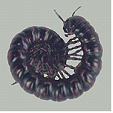
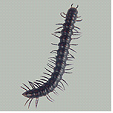
Appearance and Distribution of the Pest
Most species are native to Australia, and are most active in moist, protected areas, under leaf litter and bark, etc.
Period of Activity
Active all year in moist warm, sheltered positions.
Damage Caused
Millipedes feed on decaying plant matter, and may attack parts of plants that have been damaged by other pests, enlarging the wounds. They also feed on the underside of bulbs and can cause substantial damage.
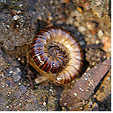
Susceptible Plants
Soft foliage and fruit of a wide range of ornamental plants at ground level or bulbs such as Daffodils and Jonquils.
Cultural Control
Dig around the base of the plant and remove by hand.
Biological Control
None known.
Chemical Control
May take snail baits.
Note
Always read the label for registration details and direction of use prior to application of any chemicals.
DISEASE
NAME
Armillaria Root Rot, Honey Fungi
Armillaria luteobubalina
Description
This naturally occurring fungus grows between the bark and wood of trees producing distinctive cream sheets of hyphae. The toadstool-like fruiting bodies are yellowish brown and appear from the soil or sprout out of the base of the host plant.
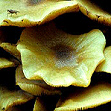
Image by Dr Brett Summerell
Symptoms
This is a vigorous fungus that attacks the roots of trees and is not normally noticed until dieback starts to occur. Affected plants generally appear declined, with some dieback and by this stage; the disease may be well established. Leaves can turn yellow, shrivel and fall from the plant and the branches die back. Citrus trees may produce a heavy crop of fruit just before death. Splits often occur on the trunk of affected trees and the bark may lift revealing white sheets of mycelium or hyphae under the bark. These hyphae will have a distinctive "mushroom" smell. Affected roots become spongy, powdery or jelly-like and when dissected reveal similar white sheaths under the bark. Infected plants may survive for many years before final death of the tree.
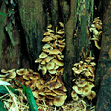
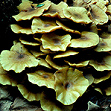
Image by Dr Brett Summerell
Source and Dispersal
This fungus is a native species that is naturally found in Eucalyptus forests and woodlands throughout eastern Australia and south-western Australia. It is commonly found on old tree trunks and decaying wood where honey coloured toadstools appear from the base of the host or surrounding soil in May-June. The toadstools produce white spores that are dispersed by wind, but generally the fungus spreads underground through contact between infected and uninfected roots. The fungus can grow about 1-1.5 metres per year along a root. This species, unlike those in the northern hemisphere does not produce rhizomorphs, thick strands that are flat resembling shoe-strings.
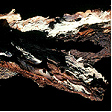 Mycelium on wood
Mycelium on wood 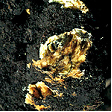
Image by Dr Brett Summerell
The fungus is not spread by contaminated soil as it only grows in root material. Spread to new sites is either through spore movement (very rare), movement of infected plants or through movement of contaminated wood chip used for mulch. Dead or dying trees should be inspected for the presence of this pathogen prior to use as mulch.
This fungus can survive for many years in infested root and stem material depending on the size of the material and speed of decomposition of the wood.
Favoured Conditions
This fungus prefers sandy soil types and is more frequently found in more freely drained soils. Moisture is required for growth of the fungus along the root system. Generally the damage caused to plants is greater on plants that are already under stress or weakened. The retention of infested root systems and stumps in the soil has contributed to an increase in the occurrence of this disease.
Affected Plants
The host range for this fungus is extremely wide and includes many ornamentals and Australian native plants. Fruit trees and perennials are also commonly attacked. The most susceptible species include oaks, camellias, azaleas, roses and eucalypts.
Amaryllis, Narcissus and Hippeastrum species are also infected.
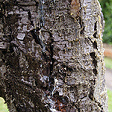 Cedrus species trunk
Cedrus species trunk 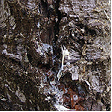
Image by Dr Brett Summerell
Cedrus species are also affected by Armillaria root rot causing the roots to rot and the trunk to swell and spilt open. There is no control for these infections.
Non-chemical Control
Control of this disease is totally dependent on removal of the inoculum of the fungus from the soil. To be effective this will require removal of the infested roots and stem, a process that may be difficult in garden beds. Infected plants should be removed and disposed of, but it is not necessary to remove the surrounding soil as the fungus only occurs in the plant. When clearing affected land for cultivation, remove all stumps and roots and allow 2 to 3 years prior to replanting.
Trees that are in the early stages of attack may be saved by removal of the affected roots and leaving remaining roots exposed for several years. Top soil around the trunk should also be removed for a distance of up to 1m and affected trees should be fertilised and watered to encourage vigour.
Chemical Control
There is no practical or effective chemical control. Fumigation has been carried out to eradicate the fungus but success is dependent on the removal of large sources of inoculum. However many of the chemicals used for this purpose are highly toxic and have restricted usage now.
Note
Always read the label for registration details and direction of use prior to application of any chemicals.
Amendments by
Dr Brett Summerell
Director Science and Public Programs
Royal Botanic Gardens Trust, Sydney
DISEASE
NAME
Virus (Generally)
Various Virus Species
Viruses can infect any plant and there are hundreds of types, but unlike fungi and bacteria viruses can only reproduce inside a living cell. Viruses are small requiring a magnification of x 10,000 to be seen and infection can be transmitted from one plant to another causing a variety of symptoms. Infected cells normal function, in the plant is diverted to aid the virus to reproduce by supplying nutrients and energy. The virus can spread from cell to cell or travel through the vascular system in the plant and may only infect a specific part of the plant, normally the new growth or the whole plant.
Lethal Yellowing
This fatal disease is not a virus, but of uncertain origin that is associated with mycroplasmas or mycroplasma-like-organism and infects palms, particularly Cocos nucifera (Coconut Palm).
The symptoms include premature dropping of the fruit at all stages (shelling) and these have brown-black water soaked areas under the calyx. The second symptom is the blacking of the new inflorescence as it is exposed from the spathe. Male flowers are also blackish and fruit will not set.
The third stage of this infection causes the lower fronds to turn yellow, eventually engulfing the entire crown. The fronds turn brown and easily fall from the plant and the infection kills the entire plant within 3 to 6 months with the crown falling away leaving a bare trunk.
Some palm species only exhibit the third stage making it difficult to diagnose, but generally a solitary frond will turn yellow, known as 'Flagging' and indicates Lethal Yellowing.
It is known to be transmitted by a plant-hopper (Myndus crudus) and currently there is no practical control.
Mosaic Virus generally is a viral problem that involves several viruses altering the production of chlorophyll in the leaf. It may only be seen on certain parts but the whole plant will be infected.
Symptoms
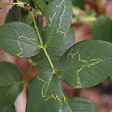
Mosaic Virus on Roses form variable yellow pattens on some of the leaves that are fine lined, imitating the veins with blotches or larger marks forming streaks.
Mosaic Virus on Cabbage, cauliflower and broccoli form yellow rings on immature leaves that turn shades of green as the leaf matures and eventually turning purplish-black in cooler weather.
The virus (Marmor iridis) infects Iris and Watsonia species leaves develop pale green streaks on the leaf that become larger then turn brown eventually killing the leaf. The virus prevails in the rhizome from season to season and is a serious problem reducing and damaging flower production.
Phloem Necrosis (Morsus ulmi) is a serious disease of Ulmus species. The initial symptoms occur at the apex and on branch tips where the leaves droop as the petiole is affected. The leaf margins curve upwards and the leaf turns greyish then yellow and then falls, overall giving the tree a sparse appearance. As the virus matures it infects the phloem tubes turning them yellowish, and then brown eventually killing the cells. The roots die and the entire tree may gradually decline over eighteen months, or in acute cases a tree may die within three weeks.
Pumpkin and zucchini are attacked from a virus commonly known as 'Watermelon virus' which affects the leaves by making them mottled in light or dark green and may become distorted. This inhibits the size of the plant and the fruit may have sunken areas with concentric rings.
Tobacco is infected by a Tobacco Mosaic virus (Marmor tabaci) and a Ring virus (Annulus tabaci).
Tulip Breaking (Marmor mite) causes yellowish-white, light coloured striping or spotting of the flower and reduces the size and vigour of the plant in Tulipa species. It may also affect the growth of the bulb and offsets and is more prevalent in double-flowering varieties.
Yellows (Chlorogenus callistephi) is a viral disease that causes leaves to turn yellow and produces shoots that are simular to Witches Broom or flowers that have poor colouring. The infection will not kill the plant as it overwinters and spreads infection from the living host via the Leaf Hopper (Macrosteles fascifrons). It is not found in the soil or in seeds but is a major problem for Aster species.
Source and Dispersal
The source and the dispersal vary depending on the particular Virus that is involved. In roses the virus overwinters on fallen leaves or pruned pieces of plant material. It is also found on infected plants and is spread by infected propagation material. Aphids transmit this Mosaic Virus.
Infected cabbage, cauliflower and broccoli are an excellent source for aphids, such as the green peach aphid to disperse.
Iris rhizomes are the source and the virus (Marmor iridis) is spread by aphids and infected rhizomes during propagation.
Phloem Necrosis is thought to be transmitted by the Elm Leafhopper (Scaphoideus luteolus) or by infected rootstocks.
Pumpkin and zucchini are infected from surrounding weeds or other infected plants by several aphids including the cotton aphid and the green peach aphid.
Generally plants are infected by viruses by, rubbing against each other or through grafting, budding and other vegetative means such as wounds. Insects also transmit viruses by sucking sap or transferring infected pollen.
Favoured Conditions
Viruses prefer warm humid climate.
Affected Plants
A wide range of plants are affected from a range of Mosaic viruses causing simular symptoms. These include roses, cabbage, cauliflower, broccoli, iris, pumpkin, zucchini, turnips, capsicum, swedes, stocks, alyssum and wallflowers. Shrubs and trees such as Ulmus species are also infected.
Abutilon species may be infected by the Mosaic Virus ((Marmor abutilon) which causes variegation of the leaves.
Aquilegi, Berberis Passiflora and Tulipa species are infected by the Cucumber Mosaic Virus (Marmor cucumeris). This causes yellow streaking or mottling in the leaves and dark coloured patches to appear on the flowers. It also stunts the plant and prevents flowering.
Lilium and Tulipa species are infected by the Mosaic virus (Marmor mite) causing yellow mottling on the leaves.
Palms are infected by Lethal Yellowing include, Pritchardia martii and Phoenix canariensis.
Non-chemical Control
With roses if the problem is minor it may be ignored as the flower production will be normal. Heavily affected plants should be disposed of.
Other plants that are infected should be removed and destroyed. The spread may be arrested by the eradication of aphids by applying soapy water.
Chemical Control
Once the virus is seen it is too late to spray. Preventative spraying to control aphids should be carried out in spring using Dimethoate. There is no satisfactory chemical control for viruses.
Average Lowest Temperature : -3º C 27º F
USDA : 9, 10
This USDA (United States Department of Agriculture) hardiness zone chart can be used to indicate a plant’s ability to withstand average minimum temperatures. However, other factors such as soil type, pH, and moisture, drainage, humidity and exposure to sun and wind will also have a direct effect on your plant’s survival. Use this chart only as a guide, always keep the other factors in mind when deciding where, when and what to plant.
A plant's individual USDA zone can be found in the Plant Overview.
Region of origin
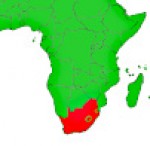
South Africa
Climate Description
Warm Temperate
This zone has the majority of rain during winter in the west and summer in the east with high humidity. Summer temperatures may peak at 40ºC (104ºF).
Frost and drought mainly occur inland and coastal wind is normally accompanied with rain.
Plant growth
Wide range of native and exotic plants grow well.
| Dictionary | Growth Habit |
| Leaf Type | Botanic Flower Description |
| Leaf Shape | Flower Inflorescence |
| Leaf Arrangement | Fruit Type |
| Leaf Margin | Bark Type |
| Leaf Apex And Bases | Flower Description |